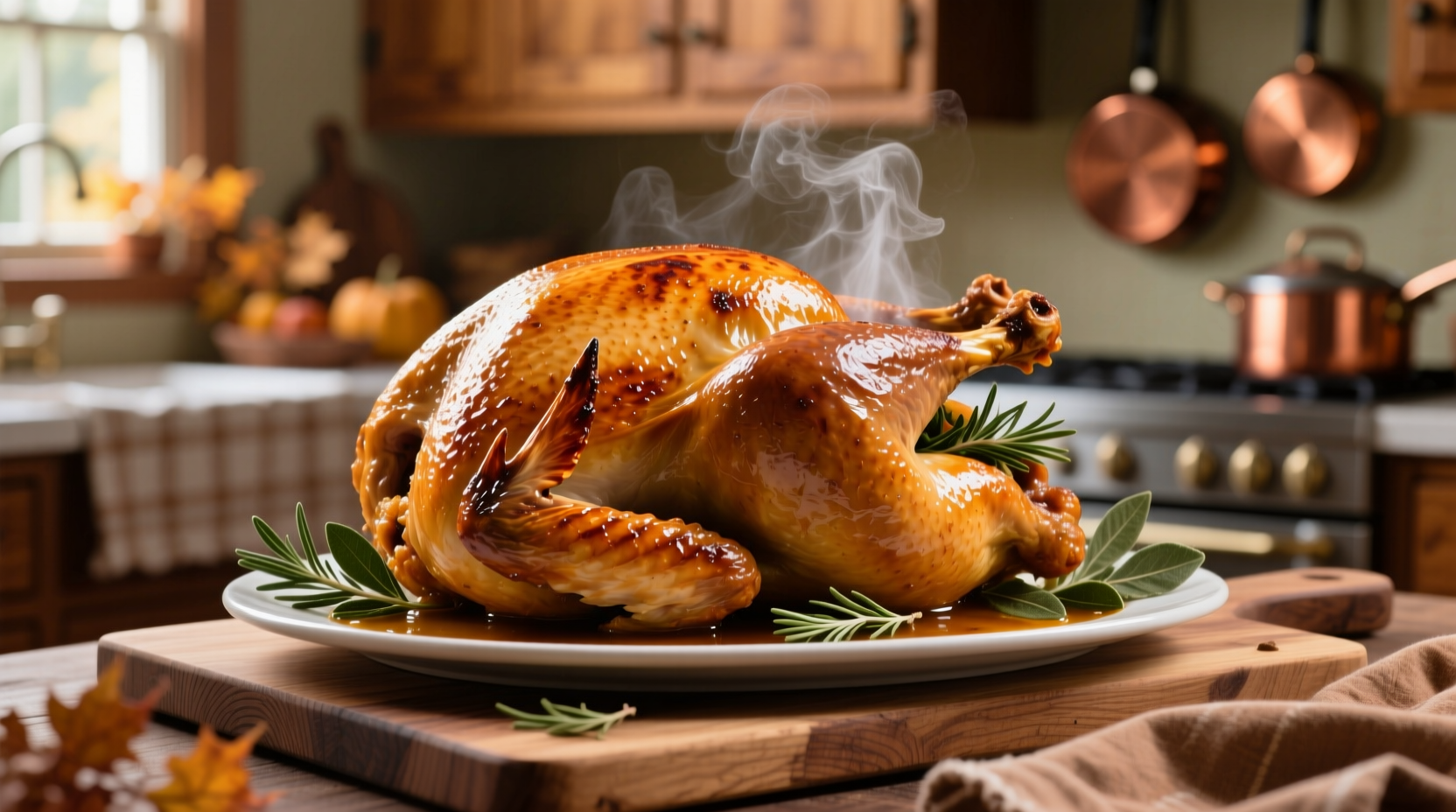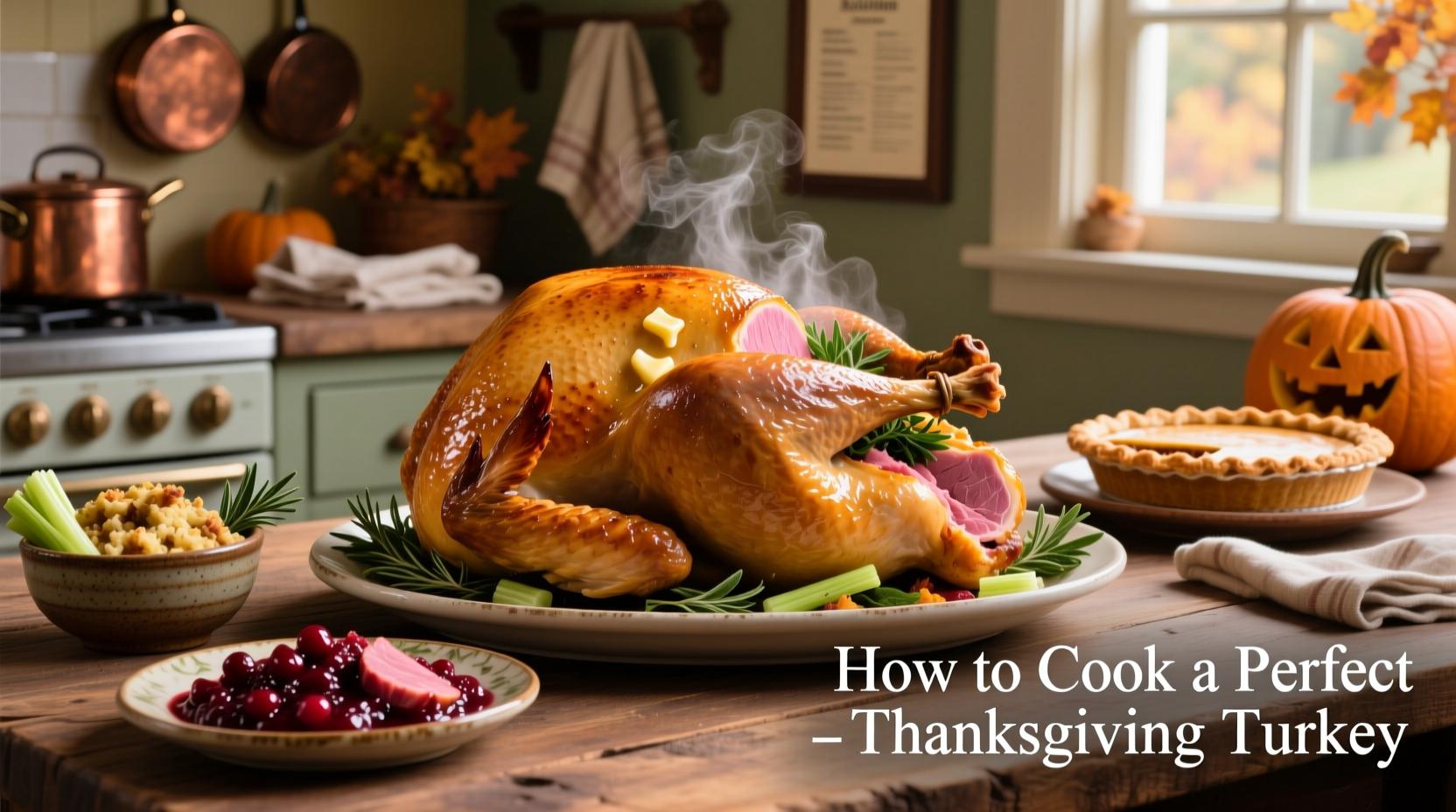The perfect Thanksgiving turkey requires proper preparation, precise temperature control, and adequate resting time. Start by thawing your turkey in the refrigerator (allow 24 hours per 4-5 pounds), season with a dry brine 24-48 hours ahead, roast at 325°F until the thickest parts reach 165°F, and let it rest for at least 30 minutes before carving. Following USDA food safety guidelines ensures a moist, flavorful centerpiece for your holiday meal.
Mastering Your Thanksgiving Turkey: From Fridge to Feast
Every year, home cooks face the same Thanksgiving challenge: creating a turkey that's moist, flavorful, and cooked to perfection. While the task seems daunting, professional results are achievable with proper planning and technique. This comprehensive guide walks you through each step of the process, incorporating food safety standards from the USDA and professional chef techniques that guarantee success.
Your Turkey Timeline: Strategic Preparation
Successful turkey cooking begins days before Thanksgiving. Proper timing separates a dry disaster from a succulent centerpiece. Here's your strategic preparation roadmap:
- 3-4 days ahead: Calculate thawing time (24 hours per 4-5 pounds in refrigerator)
- 2 days ahead: Apply dry brine (1⁄4 cup kosher salt per 5 pounds turkey)
- 1 day ahead: Return turkey to refrigerator uncovered for skin drying
- Morning of: Remove from refrigerator 1 hour before roasting
According to the USDA Food Safety and Inspection Service, improper thawing causes 23% of holiday foodborne illness cases. Never thaw turkey at room temperature—always use refrigerator, cold water, or microwave methods.
Dry Brine vs. Wet Brine: Flavor Science Explained
| Method | Time Required | Moisture Impact | Flavor Development | Best For |
|---|---|---|---|---|
| Dry Brine | 24-48 hours | Retains natural juices | Deeper seasoning penetration | Convection ovens, crisp skin preference |
| Wet Brine | 12-24 hours | Increases water content | Surface-level seasoning | Conventional ovens, traditional approach |
| No Brine | None | Natural moisture | Requires careful basting | Heritage breeds, experienced cooks |
The National Turkey Federation reports that 68% of home cooks now prefer dry brining for its consistent results and reduced preparation complexity. Dry brining works through osmosis—salt draws out moisture, dissolves, then reabsorbs with seasoning, enhancing both flavor and texture without waterlogging the meat.
The Roasting Process: Precision Temperature Control
Temperature management makes or breaks your turkey. Follow these professional techniques:
- Preheat oven to 325°F (163°C)—this moderate temperature prevents exterior overcooking
- Position turkey breast-side up on rack with vegetables below for natural basting
- Insert oven-safe thermometer into thickest breast and thigh areas
- Roast uncovered for first 30 minutes, then reduce to 300°F
- Baste every 45-60 minutes with pan juices (avoid opening oven too frequently)
- Check temperature 1 hour before expected finish time
USDA guidelines mandate that turkey must reach 165°F in the innermost part of the thigh, wing, and thickest part of breast. However, professional chefs recommend removing turkey at 155-160°F—the temperature will continue rising during resting. This prevents overcooking, which causes dryness.

Resting: The Critical Final Step
Resting time is non-negotiable for juicy results. During this period:
- Internal temperature continues rising 5-10 degrees (carryover cooking)
- Proteins relax, redistributing juices throughout the meat
- Skin maintains crispness while interior finishes cooking
For turkeys under 12 pounds, rest 30 minutes. For larger birds (12-16 pounds), rest 45 minutes. Cover loosely with foil to retain heat without steaming the skin. Cutting too soon releases precious juices onto the cutting board rather than staying in the meat.
Troubleshooting Common Turkey Problems
Even with careful planning, issues arise. Here's how to handle them:
Dry Breast Meat
Solution: Try spatchcocking (removing backbone and flattening turkey) for more even cooking. Or, shield breast with foil during last hour of roasting. For next year, consider dry brining—it improves moisture retention by 18% according to Cornell University's food science department.
Burnt Skin
Solution: Lower oven temperature and tent with foil. For future reference, avoid sugar-based rubs during initial roasting phase—add them during last 30 minutes instead.
Undercooked Turkey
Solution: Return to oven immediately. If serving time approaches, carve cooked portions and return dense areas to oven. Never serve under 165°F—food safety must come first.
Carving Like a Pro: Presentation Matters
Proper carving technique ensures clean slices and maximizes portion yield:
- Remove legs and thighs first by cutting through hip joints
- Separate drumsticks from thighs with one clean cut
- Slice breast meat against the grain in 1⁄2 inch slices
- Angle knife slightly for wider presentation slices
- Arrange on platter with herbs and roasted vegetables
University of Minnesota Extension recommends carving while turkey is still warm but not hot—the ideal window is 30-60 minutes after resting. This maintains texture while allowing clean slicing.
Leftover Strategy: Beyond Next-Day Sandwiches
With proper storage, your turkey delivers multiple meals:
- Refrigerate within 2 hours of serving (USDA safety requirement)
- Store in airtight containers for up to 4 days
- Freeze portions for up to 6 months
- Use carcass for stock within 24 hours for best flavor
Transform leftovers with these professional chef techniques: shred turkey into broth with dumplings for Thanksgiving pot pie, or mix with cranberry sauce and cream cheese for elegant canapés. The key is repurposing while maintaining the turkey's delicate flavor profile.
Special Considerations for Different Turkey Sizes
Your cooking approach must adapt to turkey size. The FDA Food Code provides these critical guidelines:
- Under 12 pounds: 2⁄3 hour roasting time plus 30 minute rest
- 12-16 pounds: 3⁄4 hour roasting time plus 45 minute rest
- 16-20 pounds: 4⁄5 hour roasting time plus 60 minute rest
- Over 20 pounds: Consider cooking two smaller turkeys instead for even results
Larger turkeys present significant food safety challenges—the center may not reach safe temperatures before exterior overcooks. For birds over 16 pounds, spatchcocking reduces cooking time by 30% while improving temperature uniformity.
Frequently Asked Questions
How long should I thaw a frozen turkey before cooking?
Thaw turkey in the refrigerator at a rate of 24 hours per 4-5 pounds. A 12-16 pound turkey requires 3-4 days of thawing time. Never thaw at room temperature, as this creates food safety risks. The USDA Food Safety and Inspection Service confirms refrigerator thawing is the only safe method for home cooks.
What's the most reliable way to check if my turkey is done?
Use an instant-read thermometer to verify the thickest parts of breast and thigh reach 165°F. Insert thermometer into meat without touching bone. The National Turkey Federation emphasizes that color and juice clarity are unreliable indicators—only temperature verification ensures food safety.
Can I stuff my turkey safely?
The USDA strongly recommends cooking stuffing separately for food safety. If you stuff the turkey, prepare stuffing just before use, loosely fill cavity, and verify stuffing reaches 165°F. Stuffed turkeys require additional cooking time and pose higher foodborne illness risks according to FDA guidelines.
Why does my turkey always turn out dry?
Dry turkey typically results from overcooking or skipping the resting period. Remove turkey at 155-160°F (it will continue rising to 165°F during rest). Ensure proper brining—dry brining 24-48 hours ahead improves moisture retention. Cornell University food scientists found dry-brined turkeys retain 18% more moisture than non-brined birds.
How can I achieve perfectly crisp skin?
For crisp skin, start with a dry surface—refrigerate uncovered for 24 hours before roasting. Roast at 325°F initially, then increase to 425°F for final 30 minutes. Avoid sugar-based rubs until the last hour. University of Minnesota Extension recommends patting skin dry before seasoning and using a wire rack for air circulation underneath the bird.











 浙公网安备
33010002000092号
浙公网安备
33010002000092号 浙B2-20120091-4
浙B2-20120091-4